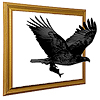
An upcoming virtual exhibit presenting works of art that portray
aspects of evolution...
for now, consider the Burgess Shale...

...............BURGESS SHALE FAUNA (1989) Carel Brest van Kempen acrylic 15" x 20"
FAUNA OF THE BURGESS SHALE
By the beginning of the Cambrian period, stromatolites (1), formations of sediment trapped by layers of cyanobacteria and other microorganisms, had been common features of shallow seas for over two billion years. The appearance of grazing metazoan organisms like trilobites and earlier creatures is thought to have caused a major reduction of these structures during the Cambrian and Ordovician.
True sponges (Phylum Porifera) appeared by the beginning of the Cambrian, and are represented here by Leptomitus (2) and Vauxia (3).
Brachiopods (phylum Brachiopoda), which would reach an impressive peak of importance and diversity during the Ordovician, made their appearance with the Cambrian, during which they probably remained fairly uncommon. .Pictured is the articulate brachiopod Billingsella (4).
One of the groups that may have given rise to the arthropods is the phylum Lobopoda, in which many experts include the bizarre Hallucigenia (5), which, until recently, was normally reconstructed walking upon its spines, with a single row of tentacles running down its back. A common Cambrian lobopod was Aysheaia (6), which is thought to have fed on sponges, with which its fossilized remains are frequently associated.
Also related to the arthropods was the extinct phylum Radiodonta, which included Anomalocaris (7), a huge swimming predator that reached a yard in length, as well as the five-eyed, nozzle-nosed Opabinia (8). The best known arthropods of the Cambrian were the trilobites, which appeared early on in the period, and enjoyed great success well into the Devonian.
Small, primitive agnostid trilobites like Lejopyge (9) proliferated during the middle Cambrian. Though shaped like bottom-dwelling (benthic) animals, their wide oceanic distribution is suggestive of a free-swimming (pelagic) lifestyle. Perhaps they lived on the water's surface, floating on little air bubbles and filter-feeding on microorganisms. The corynexochid trilobites comprised a diverse and successful order, one of the best known of which was Olenoides (10). Another large trilobite order was the Ptychopariida, which included Asaphiscus (11), the very common Elrathia (12) and Modocia (13). Naraoia (14) was an unusual trilobite, if indeed it even was a member of that taxon. Among the arthropods whose taxonomic affinities are unclear are the benthic Habelia (15) and Burgessia (16) and the backswimming Sarotrocercus (17).
The crustaceans also appeared during the Cambrian. Included in this group are the backswimming Odaraia (18), the enigmatic phyllocarid Pseudoarctolepis (19), and the crayfish-like Canadaspis (20). One of the most common arthropods of the Cambrian was the lovely little Marella (21), which may have been related to Branchiocaris (22).
Members of the phylum Priapulida, like the burrow-dwelling Ottoia (23) still persist today. Ottoia fossils have been found containing prey like the hyolithid mollusc Hyolithes (24) (phylum Mollusca).
The early segmented worm Canadia (25) (phylum Annelida) seems quite similar to some modern polychaete worms. The echinoderms comprise a large and important phylum that first arose in the early Cambrian. The primitive Gogia (26) was related to modern sea lilies.
Our own phylum Chordata was represented in the Cambrian by the wormlike Pikaia (27), which was anatomically similar to modern lancelets. Some of the unusual Cambrian animals whose affinities are hard to place include the common armored Wiwaxia (28), the sessile Dinomischus (29) and the pelagic Amiskwia (30).
